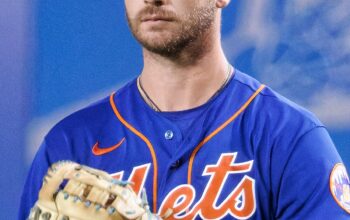NEW YORK Hours before the New York Mets defeated the Miami Marlins 7-3, co-hitting coach Eric Chavez addressed a need for improvement during the team’s morning hitters’ meeting on Friday: their performance against breaking balls.
“I put it in their corner,” Chavez said. “We do a lot of good things offensively. So you don’t want to just be like, ‘Hey, we’re not good in this area.’
“But I just told them, look, there’s a trend right now: Teams are throwing us a lot of spin, and we’re not very good on it. What do you guys want to do?”
The Mets, however, made the decision to move forward right away. Off a slider, J.D. Martinez hit an RBI single. Off a slider, Jeff McNeil launched a two-run home run. Francisco Lindor used a slider to hit an RBI triple. And it was a slider that gave Brandon Nimmo a three-run home run.
The Mets’ lineup featured better at-bats despite some persistent chasing. Chavez’s pregame remarks, however, are still relevant: the Mets (63-59) need to keep getting better against spin if they are to secure a postseason berth over the season’s remaining 40 games.
The Mets have seen more breaking balls than any other team since the All-Star break. The Mets have been hit by breaking balls 37.1 percent of the time by opposing pitchers in the second half, which is the highest percentage in MLB during that time. Though still considerably less often than the Mets, the Pittsburgh Pirates have seen the second-most (35.1%). Pitchers threw breaking balls to the Mets 32.5 percent of the time in the first half.
The increase in breaking balls is indicative of a league-wide change made in opposition to the Mets. The Mets pounded fastballs in June, when the team was playing at its peak and had the fourth-best batting run value against them. The Mets saw fastballs 56.6% of the time in June. Only the Philadelphia Phillies (50.2 percent) have seen fewer fastballs than the Mets (51.9 percent) since the All-Star break.
The Mets have struggled against breaking balls; since the middle of the second half, they are ranked 17th in batting run value against them. They have also had trouble with sweepers, sliders, and curveballs.
Up until the last three games, in which they have scored at least six runs each, the Mets’ offense had struggled in August. They were ahead of only ten other teams in August with an OPS of.707 going into Friday’s game. The pitching staff’s problems, especially with walks, have not helped New York, but the lineup is the club’s strongest suit. Furthermore, the team’s difficulties had coincided with the Mets’ 5-8 August record going into Friday night.
Chavez’s discussion of spin and the Mets’ recent struggles with it made sense. He aimed to at least raise awareness of the problem and start a dialogue about it.
According to Martinez, repetition, familiarity, and practice are the common ways to get better at stopping breaking balls. Martinez stated that you can become more proficient at hitting it the more you see it.
“It’s like when guys were throwing rising four-seamers, no one could hit, and then over time, people started hitting it,” the veteran designated hitter said. “It’s just one of those things where you have to work on it.”
That is easier said than done, though, as pitchers now frequently throw breaking balls behind in counts in circumstances where fastballs were once necessary. Also, when pitchers are throwing harder than ever, it can be particularly challenging. As a result, Chavez has advised waiting on offspeed, something he did not do until six years into a productive 17-year playing career. He claims it is evident that pitchers want to throw spin.
“This league is crazy, man,” Martinez said. “It’s stuff over command, and throw your best pitches, and if you walk him, who cares.”
Martinez is one of the few regulars in the Mets lineup that has seen a decline in 2024 in terms of output against breaking balls. After slugging.590 against them the previous year, he has only hit.273 against them this time around. Slugging against breaking balls has decreased similarly for Pete Alonso, who saw.289 in 2024 and.491 in 2023. Similarly, Brandon Nimmo will score.320 in 2024 and.543 in 2023.
Chavez stated that additional spin in practice could be helpful, but he did not publicly discuss how the Mets intended to address the problem following their meeting. One person who has benefited from this transformation is Mark Vientos. A few months back, Vientos changed the batting practice format from only seeing high velocities to a more balanced mix of fastballs and offspeed pitches.
“My belief is that if you talk about and pay attention to it, you can improve it,” Chavez said. “How good are we going to get at it? I don’t know. But we can definitely get better at it.”
Though starter Roddery Muñoz had confused the Mets in two previous appearances against them, he entered the game with a 5.67 ERA, so perhaps it had something to do with the Marlins (45-77), Friday at least appeared to be a solid start.
(Photo of J.D. Martinez: Greg Fiume / Getty Images)


